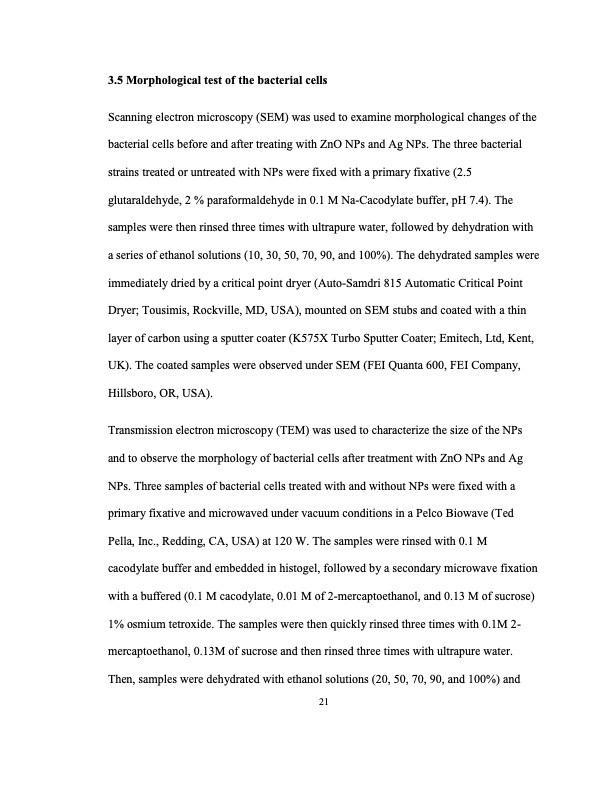
PDF Publication Title:
Text from PDF Page: 032
3.5 Morphological test of the bacterial cells Scanning electron microscopy (SEM) was used to examine morphological changes of the bacterial cells before and after treating with ZnO NPs and Ag NPs. The three bacterial strains treated or untreated with NPs were fixed with a primary fixative (2.5 glutaraldehyde, 2 % paraformaldehyde in 0.1 M Na-Cacodylate buffer, pH 7.4). The samples were then rinsed three times with ultrapure water, followed by dehydration with a series of ethanol solutions (10, 30, 50, 70, 90, and 100%). The dehydrated samples were immediately dried by a critical point dryer (Auto-Samdri 815 Automatic Critical Point Dryer; Tousimis, Rockville, MD, USA), mounted on SEM stubs and coated with a thin layer of carbon using a sputter coater (K575X Turbo Sputter Coater; Emitech, Ltd, Kent, UK). The coated samples were observed under SEM (FEI Quanta 600, FEI Company, Hillsboro, OR, USA). Transmission electron microscopy (TEM) was used to characterize the size of the NPs and to observe the morphology of bacterial cells after treatment with ZnO NPs and Ag NPs. Three samples of bacterial cells treated with and without NPs were fixed with a primary fixative and microwaved under vacuum conditions in a Pelco Biowave (Ted Pella, Inc., Redding, CA, USA) at 120 W. The samples were rinsed with 0.1 M cacodylate buffer and embedded in histogel, followed by a secondary microwave fixation with a buffered (0.1 M cacodylate, 0.01 M of 2-mercaptoethanol, and 0.13 M of sucrose) 1% osmium tetroxide. The samples were then quickly rinsed three times with 0.1M 2- mercaptoethanol, 0.13M of sucrose and then rinsed three times with ultrapure water. Then, samples were dehydrated with ethanol solutions (20, 50, 70, 90, and 100%) and 21PDF Image | ZINC OXIDE AND SILVER NANOPARTICLES ON INTESTINAL BACTERIA

PDF Search Title:
ZINC OXIDE AND SILVER NANOPARTICLES ON INTESTINAL BACTERIAOriginal File Name Searched:
thesis-zinc-oxide-silver-nano.pdfDIY PDF Search: Google It | Yahoo | Bing
Turbine and System Plans CAD CAM: Special for this month, any plans are $10,000 for complete Cad/Cam blueprints. License is for one build. Try before you buy a production license. More Info
Waste Heat Power Technology: Organic Rankine Cycle uses waste heat to make electricity, shaft horsepower and cooling. More Info
All Turbine and System Products: Infinity Turbine ORD systems, turbine generator sets, build plans and more to use your waste heat from 30C to 100C. More Info
CO2 Phase Change Demonstrator: CO2 goes supercritical at 30 C. This is a experimental platform which you can use to demonstrate phase change with low heat. Includes integration area for small CO2 turbine, static generator, and more. This can also be used for a GTL Gas to Liquids experimental platform. More Info
Introducing the Infinity Turbine Products Infinity Turbine develops and builds systems for making power from waste heat. It also is working on innovative strategies for storing, making, and deploying energy. More Info
Need Strategy? Use our Consulting and analyst services Infinity Turbine LLC is pleased to announce its consulting and analyst services. We have worked in the renewable energy industry as a researcher, developing sales and markets, along with may inventions and innovations. More Info
Made in USA with Global Energy Millennial Web Engine These pages were made with the Global Energy Web PDF Engine using Filemaker (Claris) software.
Infinity Turbine Developing Spinning Disc Reactor SDR or Spinning Disc Reactors reduce processing time for liquid production of Silver Nanoparticles.
| CONTACT TEL: 608-238-6001 Email: greg@infinityturbine.com | RSS | AMP |